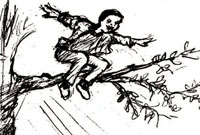Vulnerabilities
Adolescents and young people do not always act in ways that serve their own best interests. They can make poor decisions that may put them at risk and leave them vulnerable to physical or psychological harm (see Figure 2.1). Some risk-taking behaviours lead to serious lifelong consequences (for example adolescent pregnancy); while others can be corrected (for example peer pressure to consume alcohol).

Figure 2.1 Adolescents often take risks without being fully aware of the consequences.
These vulnerabilities can be categorised as physical, emotional, and socioeconomic (see Box 2.1).
By understanding young people's vulnerabilities, and the life skills that empower them, you will be in a better position to serve their needs.
Box 2.1 Vulnerabilities of adolescents
Physical Vulnerabilities:
- Adolescence is a time of rapid growth and development, creating the need for a nutritious and adequate diet.
- Adolescents often have poor eating habits which put them at risk of undernutrition as they may not be able to meet the increased demand of nutrition for growth.
- Poor health in infancy and childhood, often resulting from impoverished conditions, can persist into adolescence and beyond.
- Repeated and untreated infections and parasitic diseases, frequent diarrhoea and respiratory diseases, malnutrition, physical defects and disabilities can affect their physical and psychological development.
- Some young women may have undergone female genital cutting, which can result in significant physical and/or emotional difficulties, especially concerning sexual and reproductive matters (see Study Session 6).
Emotional Vulnerabilities:
- Mental health problems can increase during adolescence due to the hormonal and other physical changes of puberty, along with changes in adolescents' social environment.
- Adolescents often lack assertiveness and good communication skills, thereby rendering them unable to articulate their needs and withstand pressure or coercion from their peers or adults.
- Adolescents may feel pressure to conform to stereotypical/conventional gender roles.
- Young people are more vulnerable than adults to sexual, physical, and verbal abuse because they are less able to prevent or stop such manifestations of power (see Study Session 6).
- Often there are unequal power dynamics/relationships between adolescents and adults since adults sometimes view adolescents as children.
- Young people may lack the maturity to make good, rational decisions.
Socioeconomic Vulnerabilities:
- During adolescence, young people's need for money often increases, yet they typically have little access to money or money-making employment.
- Poverty and economic hardships can increase health risks owing to poor sanitation, lack of clean water, and the inability to afford healthcare and medications.
- Disadvantaged young people are also at a greater risk of substance abuse and may feel forced to resort to work in hazardous situations, including commercial sex work, (prostitution) which makes them likely to contract STIs, including HIV/AIDS, and have an unwanted pregnancy.
- Young women also face gender discrimination that affects access to healthcare, the ability to negotiate safer sex, and opportunities for social and economic wellbeing.
- Some young women marry very young to escape poverty, but as a result may find themselves in another difficult and challenging situation.
- Many young people are also at risk because of diverse socioeconomic and political reasons. These especially vulnerable young people include street children, child labourers, the internally displaced or refugees, those in war zones, young criminals, those orphaned because of AIDS and other circumstances, and other neglected and/or abandoned youth.
(adapted from Adolescent and Youth Reproductive Health Trainers' Manual, Ethiopian Federal Ministry of Health, 2008)
Last modified: Tuesday, 24 June 2014, 4:16 PM